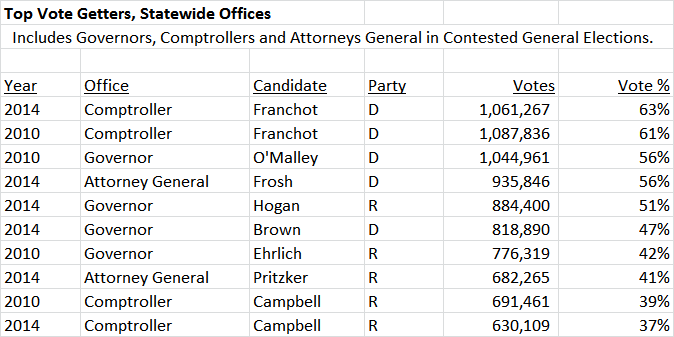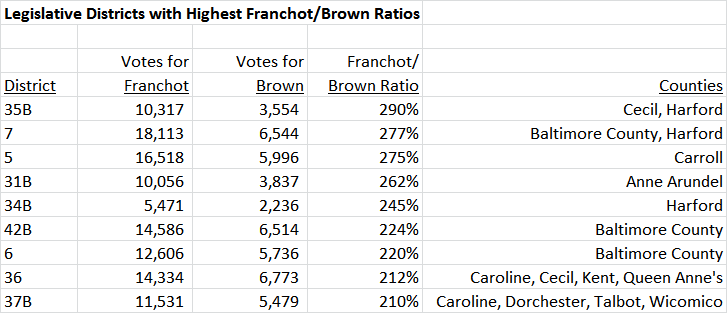By Adam Pagnucco.
Senate President Mike Miller and Comptroller Peter Franchot have renewed their decade-long feud, to the delight of journalists, bloggers and pundits alike. Whether it’s about slots, tax collection issues, Baltimore County public school air conditioners or just the joy of a good barroom brawl, the Miller-Franchot war sometimes abates but never ends. Speculation pops up every couple of years that the Senate President will find a challenger to take the Comptroller out. After all, Miller is arguably the most powerful non-Governor in Maryland history and the statehouse is his domain. But outside the statehouse, Franchot is King.
Why do I say that? Consider the following.
1. Statewide Results
Below are the vote totals and percentages of major party candidates for Governor, Comptroller and Attorney General for the last two general elections. (Attorney General Doug Gansler, who had no opponent in 2010, is omitted.) Franchot’s results are the best in the field. In fact, to find statewide politicians who regularly matched or exceeded his margins, you would have to go back more than a decade to the days of William Donald Schaefer, Louie Goldstein and Joe Curran.

2. County Results
Lieutenant Governor Anthony Brown was the ultimate creation of the state Democratic establishment. And Franchot? Well… let’s just say he’s not. Below is a comparison of the votes obtained by the two in every county in the 2014 general election. Franchot received more votes than Brown in every local jurisdiction, including Brown’s home base of Prince George’s. In the big three liberal jurisdictions (Montgomery, Baltimore City and Prince George’s), the vote totals for Brown and Franchot were similar, suggesting that loyal Democrats supported both of them. Franchot’s edge came from the rest of the state. He received at least 50% more votes than Brown in 15 of 24 counties, including the critical swing jurisdictions of Baltimore County and Anne Arundel. Brown carried just four jurisdictions against Larry Hogan – Prince George’s, Baltimore City, Montgomery and Charles. Franchot carried all of them in the general election, plus Anne Arundel, Baltimore County, Dorchester, Howard, Kent and Talbot. Tell me again why Franchot should fear the establishment?

3. Legislative Districts and Sub-District Results
The State Board of Elections has data on the performance of Franchot, Brown and Hogan for every one of Maryland’s 67 legislative districts and sub-districts. (The state has 47 Senate districts but many of them are carved up into smaller sub-districts for Delegates.) This further illuminates the electoral dominance of Franchot over Brown.
Franchot received more votes than Brown in 63 of the 67 districts. All four in which Brown did better were in Prince George’s. Franchot received more votes than either Brown OR Hogan in 32 districts – nearly half of them. Franchot’s occasional deviations from progressive orthodoxy didn’t hurt him in liberal Montgomery or Baltimore City, as he out-polled Brown in every district either entirely or partially within their boundaries.
In the following nine districts, Franchot received more than twice as many votes as Brown.

These districts go from moderately red to deep red. They are represented by a combined 8 Republican Senators, 21 Republican Delegates and 1 Democratic Senator – Baltimore County’s renegade blue dog, Jim Brochin. In many of these places, liberal Democrats are considered alien life forms. But Franchot has a following here.
Perhaps the most interesting of these districts is Dundalk-based District 6. Dundalk is a fabled ancestral home of white, blue-collar, unionized Democrats, but it has been trending to the GOP. In 2014, Hogan defeated Brown here with 76% of the vote. Democratic Delegate John Olszewski Jr. lost the Senate race to unknown Republican Johnny Ray Salling, who raised just $15,429. The district’s three Delegate seats flipped from all Democratic to all Republican – and it wasn’t close. A Republican succeeded Olszewski’s father in Dundalk’s County Council seat with 62% of the vote. Baltimore County Executive Kevin Kamenetz lost the fifteen Dundalk precincts to an obscure, underfinanced Republican by a 59-41% margin. Attorney General Brian Frosh lost to a no-name Republican here by 53-41%. But Franchot won the district 52-48.
I know what you’re thinking: Franchot had a weak opponent. Sure. But 2014 was a year in which seemingly weak Republicans had great success. They knocked out numerous Democratic incumbents, including prominent ones like Olszewski, Senator Roy Dyson, Delegates John Bohanan, David Rudolph and Norm Conway, and Wicomico County Executive Rick Pollitt. They came close to defeating Brochin and Senator Ron Young. The ultimate no-name Republican was Larry Hogan, a man who had never served in public office, had no starting name recognition and had to draw on public financing to compete with the MUCH better funded Anthony Brown. Remember when Brown referred to the general election as “a little bit of a mole hill?” But Hogan won in the best year in recent memory for “weak” Republicans. Amid all this tumult, Franchot increased his win margin in the general election by two points over 2010.
Here is the key question: could it be that Franchot’s socially liberal, fiscally moderate stance combines the best of Hogan and Brown and has made him Maryland’s most popular state-level Democrat? Maryland voters approved gay marriage and the Dream Act in 2012, and according to a recent Washington Post poll, support many liberal priorities. But they elected an openly anti-tax Governor and, according to the above poll, rank the economy and taxes as their second and third issue priorities. (Education is number one.) This mix of liberalism and moderation fits Franchot’s issue profile better than any other prominent Maryland politician.
Democrats should ponder all of this as they prepare to campaign against Hogan in 2018.
